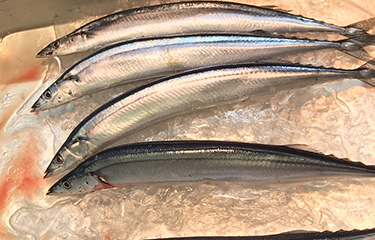In an 18 September press release, Japan’s Fisheries Information Service Center predicted the catch of Pacific saury (sanma in Japanese) in fiscal year 2020 would be lower than it was in FY 2019.
The latest prediction covers specific areas of Japan during the saury season, which kicked off in late September and will last until early November.
In early September, schools of fish were distributed only in the open sea far offshore eastern Hokkaido, and the fishing grounds were farther offshore than in the previous year. The number of fish caught was also lower than seen in the previous year. It is not expected that these fish schools will visit the eastern Hokkaido area from mid-September to early October. In late September, sampling revealed that the amount of fish visiting the high seas east of Hokkaido was lower than the previous year.
From mid-October to early November, there is a possibility that some schools of fish will approach the far north-eastern Hokkaido area around Cape Ochiishi from offshore, but the amount will be less than in the previous year, and the visits will be intermittent. Many schools of fish will migrate south while remaining offshore from the eastern Hokkaido area, and very few schools will come close to eastern Hokkaido.
In the Sanriku area of northeast Honshu Island, officials expect that there won’t be visits from late September to mid-October. There will be intermittent visits in late October, but less than in the previous year. In early November, there will be intermittent visits. Many schools of fish will also move south while staying far offshore east of the Sanriku area – Kessanuma, the nation’s top port for saury landings, is in this area.
Though Chinese overfishing is often blamed for the decline in Japan’s saury catch, climate change may play a part now.
“The warm water [of the Kuroshio Current] comes up every year now, and spreads the Oyashio [Current] to the farther area from Japan. Sanma [suary] live in very cold water, so it is difficult for Japanese fishing people to get the sanma effectively now. Maybe the sanma and ika [squid] problem is related to the physical oceanography,” Jun Nishioka, associate professor at the Pan-Okhotsk Research Center, Institute of Low Temperature Science, at Hokkaido University (who is not associated with the Japan’s Fisheries Information Service Center), said.
In a separate 31 August press release, the Fisheries Information Service Center forecasted an increase in the catch of Japanese common squid, also called Pacific flying squid.
In September, in the Joban-Sanriku area of north-east Honshu, the catch is expected to exceed that of the previous year. The area from the Tsugaru Strait to Southern Hokkaido will be about the same as the previous year. The straight divides Honshu and Hokkaido Islands. Catches in the Pacific to the east of Hokkaido are predicted to be higher than in the previous year.
Landings for the full year in 2019 were 42,300 MT. A sustained lack of squid, with four consecutive years of record-low catches, has put processors in a bind, and even caused the cancellation of local squid festivals when promoters could not obtain enough to feed the visitors. Hakodate, Hokkaido was hit especially hard, as the fishing economy relies strongly on squid processing – shiokara, or salty-spicy squid, is a local specialty.
In early catches, the amount of flying squid landed nationwide from the beginning of the year through August was 14,000 MT, an increase of 13 percent compared to the same period last year. The increase is attributed to favorable temperatures and currents in the spawning area southwest of Kyushu.
The market responded with a 20 percent drop in the wholesale squid price, while saury, which is the most representative autumn fish, continued to be priced high. The average wholesale price at the end of August at Tokyo’s Toyosu Wholesale Market was JPY 600 to 800 per kilogram (USD 5.68 to 7.58 EUR 4.88 to 6.51).
On 25 September, 12,325 kilograms of fresh flying squid sold at the Toyosu market in the range of JPY 864 to 1,188 (USD 8.19 to 11.26, EUR 7.04 to 9.68). Frozen sold from JPY 378 to 702 (USD 3.58 to 6.66, EUR 3.08 to 5.72).
Pacific saury sold fresh at Toyosu in the range of JPY 864 all the way up to 4,320 per kg (USD 8.19 to 40.96, EUR 7.04 to 35.19), with an average price of JPY 1,512 (USD 14.34, EUR 12.32). Frozen saury sold on the same day in the range of JPY 288 to 475 (USD 2.73 to 4.50, EUR 2.35 to 3.87).
Photo courtesy of Chris Loew/SeafoodSource







